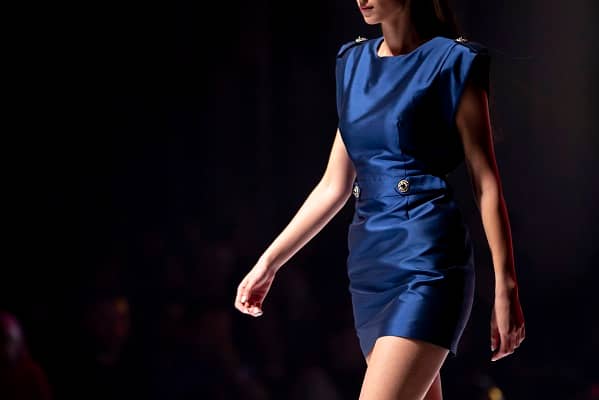There are dresses that go viral, and then there are dresses that leave an imprint—etched in the collective fashion memory, not because of gimmicks, but because of their sheer, undeniable presence. Consider the striking, electric-blue cape gown Meghan Markle wore during her 2018 visit to Fiji. With its clean lines, bold color, and impeccable, made-to-measure fit, it was a moment that solidified Safiyaa, the London-based label founded by Daniela Karnuts, as a force in modern luxury.
Safiyaa exists in the historically elusive space between haute couture and off-the-rack ready-to-wear. Demi-couture, a hybrid of bespoke craftsmanship and made-to-order efficiency, has exploded onto the scene of the past two decades, with Karnuts’ brand helping to spearhead its rise. The approach of the category challenges the conventional ideas of luxury fashion, rejecting mass production in favor of personalization while avoiding the eye-watering price tags of haute couture.
Daniela Karnuts, the woman behind it all, wasn’t formally trained in fashion. Instead, she came up through the corporate world, where she noticed a gap in the market: men had Savile Row, a place where tailoring was an art form, but where was the equivalent for women? It was that realization that became the foundation of Karnuts’ vision to create timeless, elegant pieces that endure beyond a single season.
Had it not been for the 2010 Eyjafjallajökull eruption in Iceland, Daniela Karnuts might still be working in corporate fashion, navigating boardrooms instead of atelier floors. Stranded in India after her return flight was one of the many cancelled due to the sudden nature of the volcanic event, the unexpected task of crafting a functional wardrobe from scratch became a moment of inspiration for Karnuts, who would go on to form her brand the next year.
But the real epiphany came not in the chaos of travel, but in the structure of men’s suiting. Karnuts noticed that while men had Savile Row—an entire institution dedicated to crafting made-to-measure wardrobes that would last a lifetime—women had to choose between overpriced high fashion and disposable fast fashion. Neither option offered the high-quality, investment-worthy pieces that could form the foundation of a wardrobe comparable to what men had, and in that Karnuts saw opportunity.
Safiyaa was born from a vision of what women actually need. Named after her daughter (the word “Safiyaa” means purity in Urdu), the brand launched with a small but potent collection of 12 core pieces that could be mixed and matched endlessly. Simple, right? But simplicity in fashion is notoriously elusive, requiring a discerning eye for details and a refusal to give in to fleeting trends. This is one of the defining characteristics of demi-couture, a fast-growing category of fashion that combines luxury quality with everyday wearability.
Demi-couture offers a middle ground between haute couture—the rarified, hand-stitched creations that require a bank vault’s worth of cash—and ready-to-wear, which, let’s be honest, often sacrifices quality for convenience. These pieces are still meticulously made-to-order and offer a tailored fit without the exorbitant price tag and wait time that can often come with luxury brands. Designers like Daniela Karnuts create small, curated collections that cost significantly less than traditional haute couture but are still an investment, making them appeal to clients who appreciate fine craftsmanship but don’t want—or need—the full couture experience.
The category has staying power as the fashion industry shifts toward more conscious consumption, embracing a more thoughtful approach to luxury where clothing is designed to last. Gone are the days when seasonal trends dedicated purchases. Instead, modern shoppers are looking for investment-worthy designs that feel both personal and timeless. At the same time, fast fashion’s environmental impact has seen consumers turning toward slower, more responsible alternatives, and with its limited production runs and focus on longevity, demi-couture presents an answer to the industry’s waste problem.
Interest in demi-couture has only been further-piqued by the post-pandemic fashion landscape. After years of dressing for comfort, many people are craving a return to elegance and fantasy in their wardrobes. Just as the 2008 financial crisis saw a shift toward more thoughtful, investment-based shopping, today’s uncertain economy has encouraged consumers to buy fewer, better pieces, a category where demi-couture shines.
Safiyaa’s consistency is a breath of fresh air in an industry that is obsessed with constant reinvention. When it feels impossible to keep up with the latest trend cycles, Safiyaa offers a wardrobe built on foundational pieces that remain relevant year after year. Karnuts has focused on perfecting a core range of pieces that are designed to last, keeping up with consumer sentiment by introducing new categories such as bridal and loungewear rather than making larger collections.
This commitment to longevity is what has made Safiyaa a favorite amongst celebrities. It’s why Meghan Markle chose that electric blue cape dress for her tour of Fiji, Michelle Obama has worn Safiyaa for public engagements, and why Jennifer Lopez, Gigi Hadid, and Kate Winslet have all been spotted in the brand’s signature sculptural silhouettes.
While fashion cycles through trends at breakneck speed, Daniela Karnuts has cultivated a loyal following of women who return to Safiyaa time and time again. At the heart of her philosophy is a simple idea: “I want the woman to wear the dress, and not the dress to wear the woman.” Instead of feeling like they have to overhaul their wardrobe every season, a Safiyaa woman can invest in their pieces knowing they are getting something timeless and worth the price tag. As more women look for clothing that can seamlessly fit their lives, Karnuts has essentially created a new category—one that luxury brands are only just beginning to catch up with.








